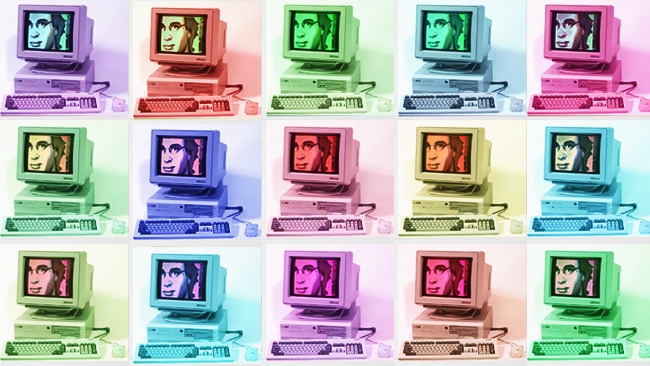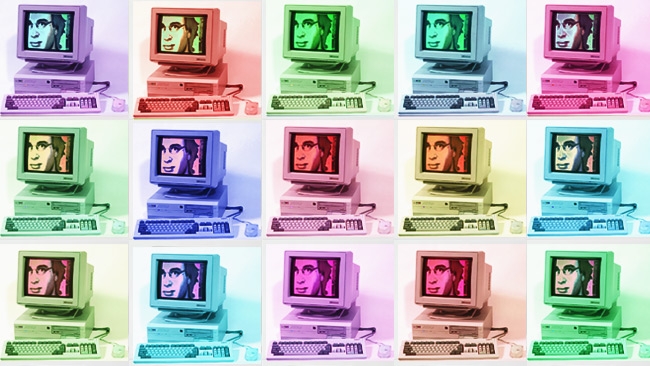
 The Amiga 4000 - as used by Warhol
The Amiga 4000 - as used by Warhol
RedShark Replay: A trip down memory lane in the company of the venerable Commodore Amiga 4000, one of the formative machines from the age of digital video.
The formative experiences of many people still currently working in film and TV will have involved one of two things: large, expensive, tape-based news cameras and deck to deck editing, or tentatively pushing a button on a Bolex and listening to silver-coated plastic rush through the gate like a waterfall made of pure money, followed by editing with a splicing block.
Neither of those approaches to acquisition and post production are long for this world in 2015, unless we're really serious purists. But for those of us born at exactly the right moment, there was a third way, something that was mainstream only for a decade or so, and that initially offered only a hint at the sort of flexibility we now take for granted.
In the early 1990s, even standard-definition nonlinear editing was a catastrophically expensive process, and financially practical only for the high-end. This was the era of the Amiga, Commodore's computer system that had famously been used, in its early generations, by Andy Warhol in the 1980s and remained prominent in the field of video and early motion graphics for its easy genlocking.
The Amiga's preeminence in the area was unmatched, in much the same way that Apple's products were, at the time, associated strongly with desktop publishing, but the hardware was modest even for the time. An Amiga 4000, host to NewTek's renowned Video Toaster card (notoriously available only in NTSC and often in effect an extremely expensive dongle for Lightwave) sported at best a Motorola 68040 processor clocked at a princely 50MHz. Upgrades to 68060s and the IBM PowerPC 600-series CPUs used in Macs of the time didn't appear until years later, after it was really too late. By default, the Amiga 4000 didn't even have 24-bit graphics capability, just a 256-colour display of broadly the same capability of a 386-era PC, with some ability to do more with the esoteric hold-and-modify modes of its custom graphics hardware. Frame buffers capable of full 16.7 million colour displays were extra, as was more than a few megabytes of RAM. At launch, the A4000 was powerful and competitive, but nothing of that level of capability was ever cheap.
Similarly expensive was something like a VLab Motion card, the hardware MJPEG codec that made it possible to store standard-definition pictures on the hard disks of the time – and let's not even talk about the cost of a five hundred megabyte hard disk in the early 90s. The performance limitations of the disks meant that the media storage drive was generally attached directly to the frame grabber, and formatted with a custom filesystem designed to do nothing more than store JPEG frames. Solving the audio problem could also be complex, as the Amiga by default had four channels of eight bit audio output, although these could be combined in software to create a stereo, fourteen-bit output. There was no audio input without additional hardware. Ethernet boards for the Amiga's custom Zorro plug-in expansion bus cost a fortune.
The fact that the entire first season of Babylon 5 had its CG effects work done on Amigas, by the now-defunct Foundation Imaging, is nothing short of miraculous given the constraints of the time. It must have cost a king's ransom in circuit boards.
Clearly, this was not a sensible prospect for home users, but desperate measures could be improvised. Your narrator's first vaguely-serious experiences behind a camera involved Sony's CCD-V6000E, a single-chip Hi8 camcorder with something approaching a usable, shoulder-mounted layout and a terrible manual lens which nonetheless seems attractive compared to some of today's servo-driven efforts. The camera produced 4:3, interlaced, standard-definition pictures, and, I now realise, slightly soft and milky ones at that. Even so, there could be no hope of capturing all that data to an affordable post production system, and the default option was tape-to-tape editing. The closest approximation to nonlinear editing involved an Amiga 1200 with – wait for it – the seminal Vidi-Amiga 12 parallel port frame grabber, which was capable of capturing either slightly ropey colour stills, or low resolution greyscale images about once every third of a second. Combine that grab rate with the automatic pause-advance speed of the V6000 camera, and we have achieved a princely 12.5fps, 320 by 240 pixel video sequence in 16 shades of grey, with no audio.
Things have come on a bit since then.
The possibilities of this situation, however, were intoxicating. I don't want to claim to have been the first person ever to have dodged a muzzle flash onto the end of a wooden gun – they were doing similar things for Babylon 5 around the same time – but there was a certain satisfaction in being able to render things in Imagine, a 3D graphics package vaguely similar to very early versions of Lightwave but much cheaper, and drop them into shots of schoolfriends reacting to fresh air.
Software and storage
In many ways the software situation was parlous: the only way to make cuts was to load the raw grabbed footage into Deluxe Paint, trim the unwanted frames, then load the main sequence and append the new shot. Deluxe Paint, it should be remembered, was released by Electronic Arts, back in the days when that name directly meant something, and was by far the leading piece of graphics software in that era of computer art and games development. It was miserable by modern standards, of course, but even grading was possible – the animation formats of the time supported a palette per frame, so not only could we have images in 16 shades of grey, we could have images in 16 shades of – say – blue or green, too. On a per-frame basis, every manner of psychedelia could be achieved.
Storage was, of course, tricky. Amigas frequently used the RIFF file structure that's the basis of things like AVI and WAV files, including the broadcast wave extensions which are currently popular. The IFF-ANIM format for animations used delta compression, storing the differences between frames. Even in four-bit greyscale, normal video noise was enough to ensure that the delta compression rarely did much, and data rates were generally somewhere near the theoretical maximum of half a megabyte per second. This seemed heady at the time, and the only realistic option was something like the Syquest EZ-135 drive, providing about 135MB of storage (equal to a staggering four and a half minutes of animation!) on cartridges. This was Syquest's answer to Iomega's much more successful Zip drive, and it quickly became difficult to get the cartridges, but with internal hard disks stuck at half a gigabyte it seemed like nirvana.
The Amiga, tragically, was never developed beyond the A4000. The operating system was extremely good, but the technology rather dead-end, using a processor line with no memory management unit which therefore could not enforce memory boundaries on programs, so any malfunctioning or malfeasant software could easily take out the entire OS. Most of what made an Amiga and Amiga was implemented on custom silicon, and things like the graphics ASICs could never have hoped to keep up with the likes of Nvidia and (at the time) ATI, Matrox, and the others.
The preeminence which had been achieved in the field of video graphics was therefore lost by a company unwilling to put in the amount of development that would have been needed to stay abreast of the sheer brute force of PC hardware. Ultimately, of course, even Apple became unable to keep up, and went over to using Intel hardware, but there would have been nothing stopping Commodore doing that too, with Amiga. The flame is kept alive to this day by enthusiast groups and new Amiga hardware, for version 4.0 of the operating system, is still occasionally developed, although it is at best a curiosity now.
We really knew the video we got out of this setup was terrible at the time, and the fact that everyone's cellphone is now much, much more powerful than an early 90s nonlinear edit workstation is rather welcome. Half a megabyte – that is, four megabits – of bandwidth is now considered reasonably healthy for an internet stream of six times the linear resolution, twenty-five times the pixel count, six times the bit depth and twice the frame rate. Even so, it's hard not to look back at these beginnings without a certain rosy tint – at least, if you picked a gradient of rosy tints to replace that four-bit greyscale.
Tags: Technology


Comments